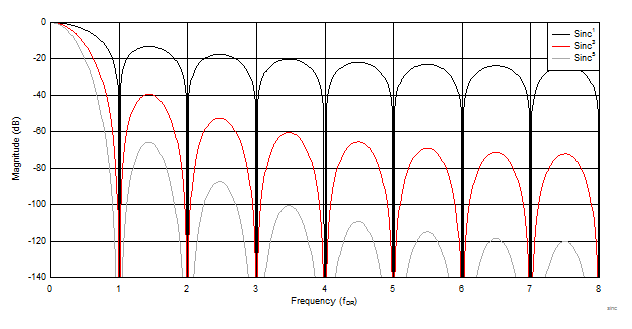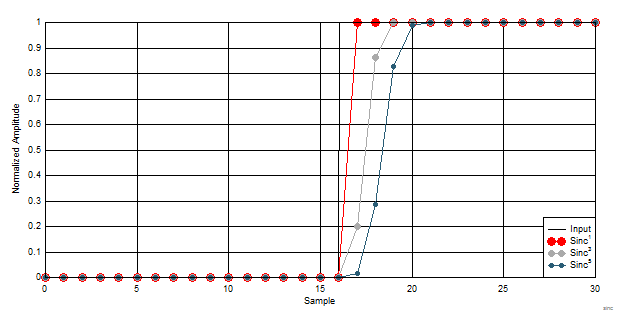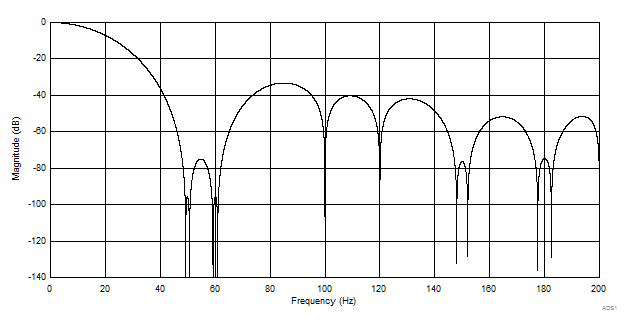SBAA230A May 2017 – March 2023 ADC128D818 , ADS1000 , ADS1000-Q1 , ADS1013 , ADS1013-Q1 , ADS1014 , ADS1014-Q1 , ADS1015 , ADS1015-Q1 , ADS1018 , ADS1018-Q1 , ADS1100 , ADS1110 , ADS1112 , ADS1113 , ADS1113-Q1 , ADS1114 , ADS1114-Q1 , ADS1115 , ADS1115-Q1 , ADS1115L , ADS1118 , ADS1118-Q1 , ADS1119 , ADS1120 , ADS1120-Q1 , ADS112C04 , ADS112U04 , ADS1130 , ADS1131 , ADS1146 , ADS1147 , ADS1148 , ADS1148-Q1 , ADS114S06 , ADS114S06B , ADS114S08 , ADS114S08B , ADS1158 , ADS1174 , ADS1178 , ADS117L11 , ADS1191 , ADS1192 , ADS1194 , ADS1196 , ADS1198 , ADS1202 , ADS1203 , ADS1204 , ADS1205 , ADS1208 , ADS1209 , ADS1216 , ADS1217 , ADS1218 , ADS1219 , ADS1220 , ADS1222 , ADS1224 , ADS1225 , ADS1226 , ADS122C04 , ADS122U04 , ADS1230 , ADS1231 , ADS1232 , ADS1234 , ADS1235 , ADS1235-Q1 , ADS1240 , ADS1241 , ADS1242 , ADS1243 , ADS1243-HT , ADS1244 , ADS1245 , ADS1246 , ADS1247 , ADS1248 , ADS124S06 , ADS124S08 , ADS1250 , ADS1251 , ADS1252 , ADS1253 , ADS1254 , ADS1255 , ADS1256 , ADS1257 , ADS1258 , ADS1258-EP , ADS1259 , ADS1259-Q1 , ADS125H01 , ADS125H02 , ADS1260 , ADS1260-Q1 , ADS1261 , ADS1261-Q1 , ADS1262 , ADS1263 , ADS1271 , ADS1274 , ADS1278 , ADS1278-EP , ADS1278-HT , ADS1278-SP , ADS127L01 , ADS127L11 , ADS127L21 , ADS1281 , ADS1282 , ADS1282-SP , ADS1283 , ADS1284 , ADS1285 , ADS1287 , ADS1287D , ADS1288 , ADS1291 , ADS1292 , ADS1292R , ADS1293 , ADS1294 , ADS1294R , ADS1296 , ADS1296R , ADS1298 , ADS1298R , ADS1299 , ADS1299-4 , ADS1299-6 , ADS130B02-Q1 , ADS130B04-Q1 , ADS130E08 , ADS131A02 , ADS131A04 , ADS131B02-Q1 , ADS131B04-Q1 , ADS131B23 , ADS131B23-Q1 , ADS131B24-Q1 , ADS131B26-Q1 , ADS131E04 , ADS131E06 , ADS131E08 , ADS131E08S , ADS131M02 , ADS131M02-Q1 , ADS131M03 , ADS131M03-Q1 , ADS131M04 , ADS131M04-Q1 , ADS131M06 , ADS131M06-Q1 , ADS131M08 , ADS131M08-Q1 , ADS1601 , ADS1602 , ADS1605 , ADS1606 , ADS1625 , ADS1626 , ADS1672 , ADS1675 , AMC1035 , AMC1035-Q1 , AMC1106E05 , AMC1106M05 , AMC1204-Q1 , AMC1210 , AMC1303E0510 , AMC1303E0520 , AMC1303E2510 , AMC1303E2520 , AMC1303M0510 , AMC1303M0520 , AMC1303M2510 , AMC1303M2520 , AMC1304L05 , AMC1304L05-Q1 , AMC1304L25 , AMC1304L25-Q1 , AMC1304M05 , AMC1304M05-Q1 , AMC1304M25 , AMC1304M25-Q1 , AMC1305L25 , AMC1305L25-Q1 , AMC1305M05 , AMC1305M05-Q1 , AMC1305M25 , AMC1305M25-Q1 , AMC1306E05 , AMC1306E25 , AMC1336 , AMC1336-Q1 , AMC3306M05 , AMC3306M25 , AMC3336 , AMC3336-Q1 , LMP90077 , LMP90078 , LMP90079 , LMP90080 , LMP90080-Q1 , LMP90097 , LMP90098 , LMP90099 , LMP90100 , TLA2021 , TLA2022 , TLA2024
3 Sinc Filter
The name “sinc” comes from its frequency response, which takes the form of the sin(x) / x function. The reason the filter has this response is actually tied closely with why it is so often used in delta-sigma ADCs.
The digital filter creates a digital output code by summing the modulator output over a certain number of modulator clock periods. The ratio of the modulator rate (fMOD) of the delta-sigma ADC to its output data rate (fDR) is the OSR. This is equivalent to taking a moving average of those samples over the sampling period. Taking the moving average in the time domain translates to a first-order sinc response in the frequency domain. The sinc response is equal to zero at integer multiples of the data rate, which appear as notches in the magnitude response plot of the filter.
The amount of averaging increases when cascading multiple sinc filters in series, thus increasing the filter order. In the spectrum, this corresponds to a lower cutoff frequency and a higher stopband attenuation, which in turn reduces noise. Figure 3-1 shows the difference in the frequency responses of a first-order sinc filter (sinc1), three sinc filters in series (a third-order sinc, sinc3) and five sinc filters in series (sinc5).
 Figure 3-1 Frequency Response of Sinc1, Sinc3, and Sinc5 Digital Filters
Figure 3-1 Frequency Response of Sinc1, Sinc3, and Sinc5 Digital FiltersLooking at these responses, there does not seem to be very much bandwidth in the digital-filter output, limiting the measurable signal content. This is not a drawback in certain low-bandwidth applications. Some precision sensor applications, like temperature and pressure sensors, do not require much bandwidth for measurement, but need a good low-pass filter to reject out-of-band noise. The sinc filter fits well into these applications.
Given the application, it may be desirable to multiplex between multiple sensor inputs relatively quickly. To do this, the digital filter needs to respond to an input change and settle quickly. The sinc filter is ideal for this, too. Sinc filters offer much faster settling times relative to other digital filters with more finely tuned frequency responses. In many cases, these filters can be built to settle to a step input in a single conversion cycle.
Nevertheless, trade-offs exist even between the types of sinc filters. The higher order a sinc filter is, the longer it will take to settle – but with the bonus of better stop-band attenuation. Figure 3-2 shows how the sinc1, sinc3 and sinc5 filters respond to a unit step input. Note that the order of the sinc filter matches the number of samples it takes to settle to the input.
 Figure 3-2 Step Response for Sinc1, Sinc3, and Sinc5 Digital Filters
Figure 3-2 Step Response for Sinc1, Sinc3, and Sinc5 Digital FiltersSome data converters have slightly modified sinc filters. In some industrial applications, power utility interference pollutes the environment of the equipment at 50 Hz or 60 Hz. A digital filter that has notches in its frequency response at 50 Hz or 60 Hz helps reject the utility frequency and maintain high system power-supply rejection (PSR).
In many cases, these filters can be built to settle to a step input in a single conversion cycle. However, a filter that settles within a single cycle will not have as much out-of-band rejection as an unmodified higher-order sinc filter. Figure 3-3 shows the magnitude response of the digital filter on the ADS124S08 when the data rate is set to 20 SPS using the low-latency filter. Note that this filter simultaneously rejects both 50 Hz and 60 Hz. A normal sinc filter would require a data rate at some integer divisor of 10 SPS to achieve this, since filter notches would occur at multiples of 10 Hz.
 Figure 3-3 Magnitude Response of the ADS124S08 Digital Filter, fDR = 20 SPS
Figure 3-3 Magnitude Response of the ADS124S08 Digital Filter, fDR = 20 SPSIn summary, the sinc filter is used as a basic low-pass filter in delta-sigma ADCs. Their reasonable stopband attenuation combined with their quick step response make them ideal for dc measurement applications, especially when multiplexing between several input signals.